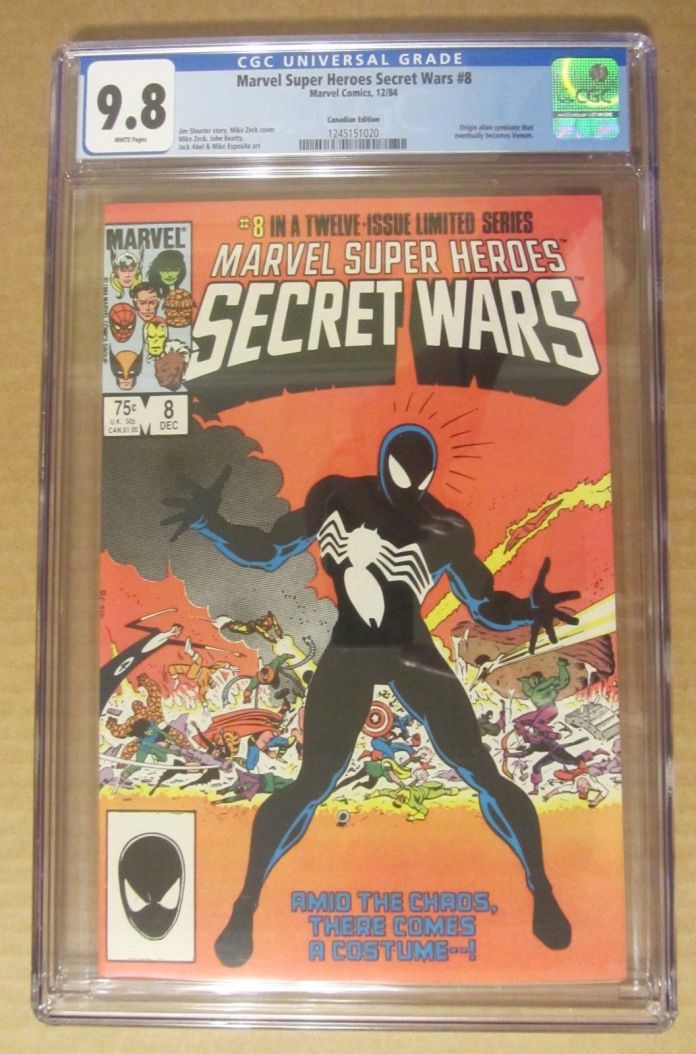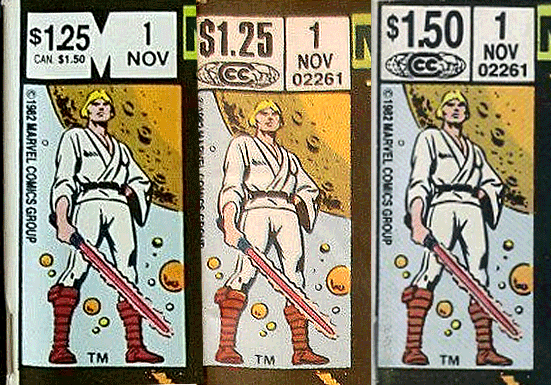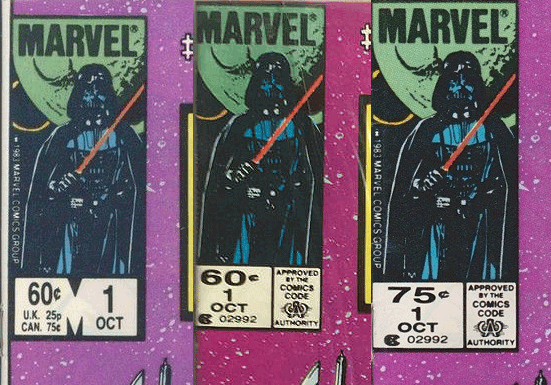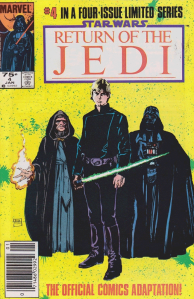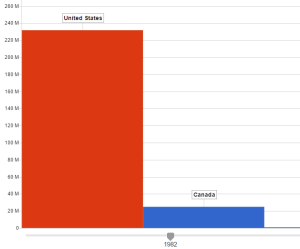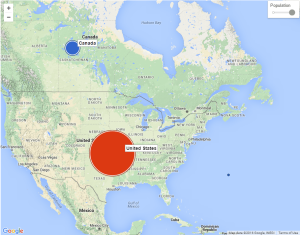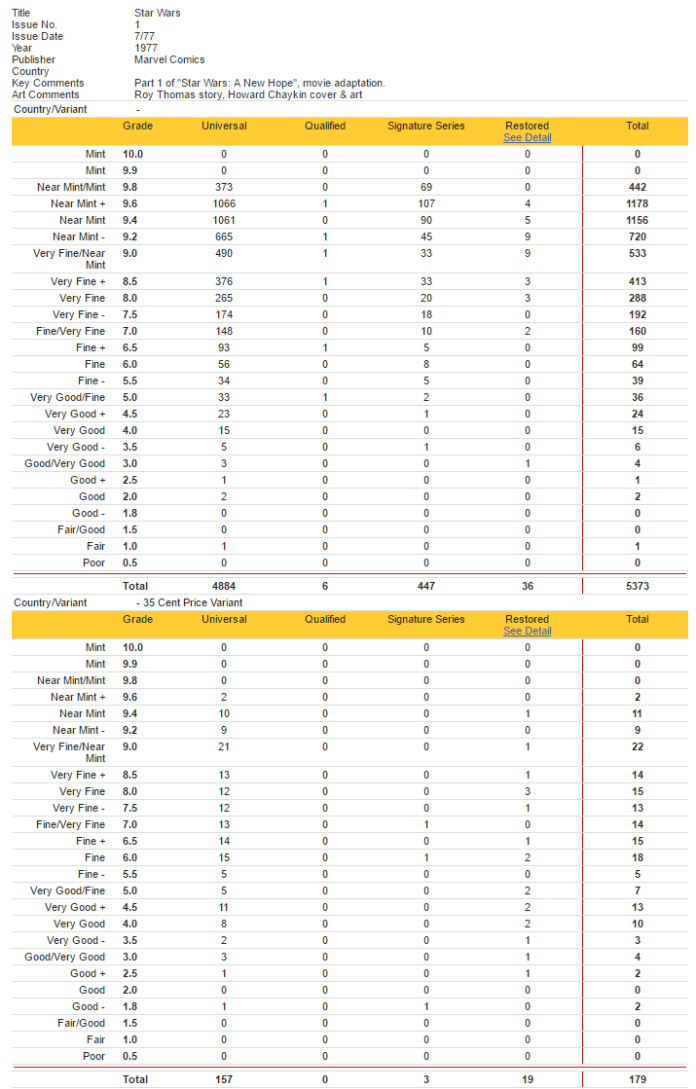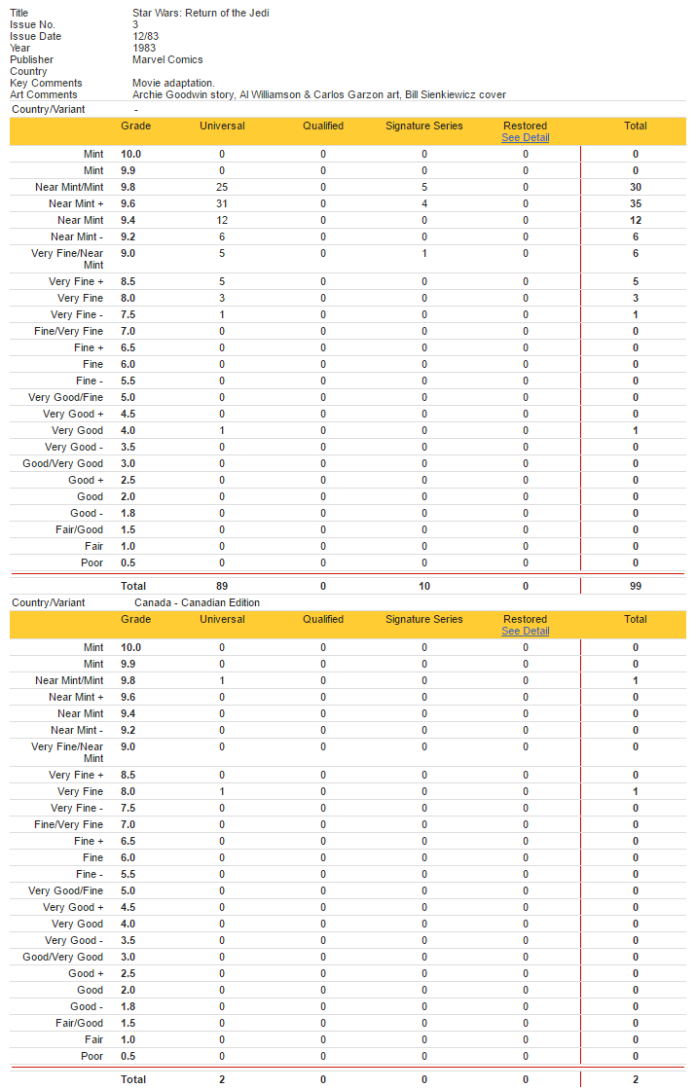By Benjamin Nobel, October 29, 2018
“When collecting any given key comic book issue, it is better to have two ways to win, than just one.”
We have just published The 2019 Price Guide for 1980’s Marvel & DC Newsstand Canadian Cover Price Variants (Type 1A), which included a few new features this year — one of which is a new Market Reports & Articles section.
My fellow collaborators have done a fine job presenting discussions about the state of the market for 1980’s price variants, including example sale highlights, and so for my report I decided to approach a discussion from a different angle: to give you an update on the “two ways to win” strategy that I’ve been advocating for so long on this blog.
What is the strategy? For newer readers, let me describe it by painting a scenario. Suppose it is the mid 1990’s and you decide you want to collect a copy of Star Wars #1 (Marvel Comics, 7/1977). Before embarking on your collecting quest, it would be very useful for you to know that there exist both 30¢ cover price 1st print types as well as 35¢ cover price 1st print types of that issue, and that the higher cover price type is actually dramatically more rare than the lower cover price type.

Star Wars #1 35¢ Variant
Suppose at the time you embark on your collecting quest, the relative rarity of the 35¢ type versus the 30¢ type is not very widely known in the hobby: it might be possible for you to pay “regular price” (or close to it) for the more-rare 35¢ version! If you can accomplish that feat of landing the 35¢ version for a cost basis close to regular market value, you’ve just given yourself two ways to win instead of one: (1) the issue number itself may rise in value, and (2) collectors of the future may be willing to ascribe a hefty premium to the more rare type, as its rarity becomes better known throughout the hobby.
Had you executed such a strategy back in the early days of 35¢ variant awareness, today you’d be grinning from ear to ear — because look where the Overstreet price guide values the two different types today in its most recently released guide (OPG #48):
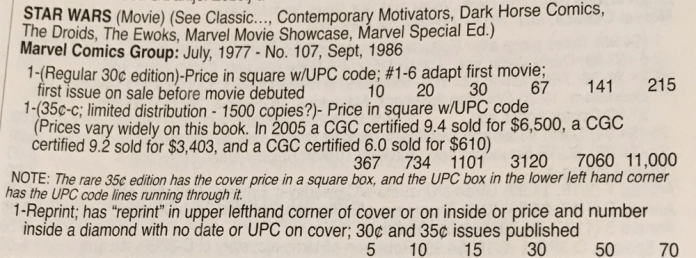
The regular 30¢ 1st print type is given a $215 value in 9.2 by Overstreet, while meanwhile the more-rare 35¢ type is given an $11,000 value in 9.2 — that’s a premium of ~51x for the price variant over its regular counter-part!
But that ~51x premium didn’t happen overnight… it built over the years, even after the rarity difference was widely known throughout the hobby. For example, check out how that premium has grown over the last eight years — here’s the same Overstreet guide page from back in 2010 (from OPG #40):

As you can see above, back then the regular 30¢ 1st print type was given a $95 value in 9.2 by Overstreet, while meanwhile the more-rare 35¢ type was given an $2,500 value in 9.2… for a premium of ~26x for the cover price variant.
With 20/20 hindsight, Star Wars #1 clearly would have been a good pick for a key issue to collect back in 2010, as its “base value” (the 9.2 Overstreet guide value for the regular 30¢ type) has grown at a +10.7% annualized rate of return during these past eight years.
But what about the 35¢ type? Even at a monster premium of 26x back in 2010, you were still better off collecting the cover price variant: because in the ensuing years, the 35¢ type would increase in value by +20.3% annualized!
Looking at this result, it is clear that those who had the choice but decided to collect the regular 30¢ type instead of the more-rare 35¢ variant lost out on all that additional upside. To illustrate this, suppose in 2010 you had invested $10,000 in each of the two types. At the 9.2 guide values back then, that would have resulted in a box of about 106 copies of the 30¢ type (rounding up a smidge) versus 4 copies of the 35¢ type. Fast-forward to today and here are what the two $10K investments would be worth at today’s 9.2 guide values:

“You won in two ways with the cover price variant.”
So in the above hypothetical scenario, had you invested your $10K into the plain old 30¢ type and ignored the cover price variants, you missed out on roughly $21,210 of upside! And that’s from a starting point where the 35¢ variant already had a guide value twenty six times higher than the regular cover price copies! With 20/20 hindsight, clearly you did dramatically better going with the 35¢ variant — because you “won” in two ways: (1) the issue number itself grew in value, and (2) the cover price variant premium over regular copies expanded in multiple. You won in two ways with the cover price variant.
Let’s keep that result in mind, as we fast-forward to a 1980’s key: Suppose you now decide you want to collect a copy of Amazing Spider-Man (ASM) #238 (Marvel Comics, 3/1983). Is there a “Two Ways To Win” collecting strategy?
You bet there is!!!
Before embarking on your ASM #238 collecting quest, it would be very useful for you to know that there were two distinct distribution channels through which comics of that era were sold: (1) newsstand sales, and (2) direct edition sales. The prevalent direct editions have a Spider-Man logo in place of a bar code, and were ordered by comic shops at a discounted but non-returnable basis — that Spidey Head logo was a way for the publisher to identify a direct-sold copy and be able to refuse refund and say “sorry comic shops: you’re stuck with any unsold copies!”
Newsstand editions meanwhile have a bar code, such copies were treated/handled by newsstand staff like magazines (i.e. something to read) and sat on newsstands waiting for a buyer… any unsold copies were returned to the publisher and typically pulped/recycled forward. The newsstand copies that sold tended to be purchased by readers (as an “entertainment purchase”) instead of by collectors (who instead were over in comic shops loading up on direct editions and carefully placing them in plastic bags), and thus newsstand copies saw a notoriously high destruction rate as compared to their well-preserved direct edition counter-parts.
So: collectible-condition surviving newsstand copies of the 1980’s are considerably harder to find versus collectible-condition direct edition copies… That already gives us a second way to win: to go for the more-rare collectible-condition newsstand survivor, versus settling for a prevalent direct edition copy…

But as readers of this market report already know — because you already read our guide intro — during a window of time in the 1980’s, Marvel actually published two distinct newsstand types: a lower cover price 1st print type (60¢ in the case of ASM #238), and a higher cover price 1st print type (75¢ in the case of ASM #238). And that the higher cover price type is by far the most rare type — the target market for that type had ~1/10th the population! [Here is a rarity walkthrough with explanatory graphics, here is Paul’s “common sense approach” to understanding their scarcity, and here is Doug’s scarcity discussion.]
Conclusion: going after that dramatically-more-rare 75¢ cover price variant type gives us our strongest “Two Ways To Win” when collecting our ASM #238.
Back when I began this blog, it was widely possible to collect the cover price variant (CPV) for any given 1980’s key published during the price variant window, and pay “regular price” for it: awareness throughout the hobby about this type of variant was historically sparse back then, so there were many people who owned variants in their collections without realizing it, i.e. they knew they owned Amazing Spider-Man #238, but did not realize there was anything different or special about their copy, with its 75¢ cover price.
“I refer to such listings with generic titles but pictured variants as “mis-listed” variants.”
Such a person, when looking to sell, might look up the recent OPG guide value or the recent market price that the issue number in general was selling for, and then list their rare variant on a buy-it-now asking “regular market price” for it (or auction it off). Since they did not realize their copy was anything special, they would choose a “generic” listing title (e.g. “Amazing Spider-Man #238, Marvel Comics, 1983”) as opposed to a title that would allow CPV collectors to find it in a refined search — no “Variant” in the title, no “Canadian”, no “Newsstand”, no “CPV”, nothing you might search for when looking for this type of variant. But zoom in on the picture to see the cover price, and it would clearly show the variant. I refer to such listings with generic titles but pictured variants as “mis-listed” variants. Many of us have been successfully hunting down such opportunities for years (high five, fellow hunters!).
And that brings me to my Update on the Two Ways To Win Strategy. Applying this strategy to my own collecting of 1980’s CPVs, my approach over the years can be described by the below “decision tree” [it is a general representation of the approach but some things are “assumed” such as, for example, that there is a “grade hurdle” in mind for the variant in advance of hunting for it — personally I aim for “9 out of 10” on the grade scale (VF/NM) and if I can exceed that goal I’m thrilled]:

For years, my collecting of these variants mostly ran along two paths down the branches — often, I could hunt through listings and either find myself a “mis-listed” variant to collect…

… or I felt confident that with enough patience — which I should make clear was often measured in months or even years of waiting — I would eventually see a mis-listed variant come onto the market:

I’m not the only one who has pursued this collecting approach, and here’s why the approach is important to understand when considering the current state of the CPV marketplace: for many years, given the state of collector awareness (unawareness) of these cover price variants, I was reluctant to traverse down the branches towards that “pay a premium” box for a given issue. I was so confident that with the passage of enough time I’d eventually land myself a mis-listed variant copy of the issue I was looking for, that I was very reluctant to pony up a premium price.
That may sound hard to understand when at the same time (1) I’d mentioned before that it could be months or even years between mis-listed variant sightings for given issues, and (2) clearly I am someone who has studied the rarity of these variants and I know very well that they are deserving of a hefty premium. So why was I so reluctant to pony up a well-deserved premium? Consider this: suppose hypothetically that you have a given issue where you tend to see a mis-listed variant hit the market once a year. Waiting around for that opportunity might sound nearly futile. But suppose for sake of argument that you have 365 different variants you are hunting for, each of which tends to produce a mis-listed variant opportunity once a year? Well my friends, on any given day you should expect that an opportunity would come your way! You just wouldn’t know which opportunity. [By the way, this was the inspiration for this year’s Top 365 / A Variant A Day list].
So picture yourself executing this strategy of hunting for mis-listed variants over the years… As the years progress, and more and more collectors learn about the variants, more collectors then recognize when they own variants and in turn more often list them properly. Thus, over time, you begin seeing fewer and fewer mis-listed variant opportunities. Instead of an opportunity per day among your hunt list of issues, you’re seeing an opportunity per week… then every couple of weeks… then even longer… Now suppose a new key issue catches your attention to collect, one which you do not already own in any grade — i.e. something you have not been trying to collect or upgrade, until today, so that you do not even own one single starter copy of the variant. How are you going to approach the decision tree? In today’s marketplace of rapidly increasing variant awareness, you are probably going to be increasingly willing to traverse down that “pay a premium” path:

And speaking for myself, that above path down the tree is where I have been finding myself these days. For example, one of the issues I collected in the past year was Detective Comics #583 (February 1988, first appearances of Ventriloquist and Scarface, and a gorgeous Mike Mignola cover). It was during one of the proof-reads of our 2018 guide that decided I wanted to own this variant. Let’s go down the tree: Were newsstand copies published for the issue? Yes. Do Type 1A cover price variant newsstand copies exist? Yes! Was I able to find a “mis-listed” variant for sale at “regular” price? No. Not a mis-listed copy in sight, at any price. I decided very quickly that I’d be willing to pay a premium for a properly-listed copy. But there were zero properly-listed copies available. I found myself waiting for one. And waiting for one. And waiting for one…

Detective Comics #583 $1.00 Price Variant
Eventually, a variant appeared on the market! It was properly listed, with the listing title identifying it as the variant, reading: “Detective Comics – 583 – Rare 1.00 Price Variant! – DC Comics – NM- 1988″… The buy-it-now cost with shipping was $58.12, representing a premium price over the going rate for direct editions in the same grade. Friends, I didn’t even hesitate: I slammed that buy button. And I’m so glad I did — I have yet to see its equal come onto the market since. In fact, I sent my copy to CGC, and as of today the CGC census still shows only one variant copy on record for the issue… my copy. I tell this anecdote to illustrate how my own behavior has changed over the years, as the hobby’s awareness of this type of cover price variant has grown. How many others like me fit this description, and how are we impacting the CPV marketplace in the aggregate?
I do still see mis-listed variants out there as well — those opportunities certainly haven’t yet “dried up” completely (here’s a mis-listed variant I landed recently) — but nowadays I do find myself time and again traversing the tree down towards that “pay a premium for a properly listed copy” box. If other market participants are behaving like me, then mis-listed-variant-hunters are increasingly losing their patience to wait for mis-listed opportunities and are realizing that the best move, if we actually want to land that variant we’re looking for, is to be willing to pony up that hefty premium (especially in the highest grades where supply is so very limited). This marketplace behavior change which I observe in myself — and then potentially multiplied across other mis-listed variant hunters out there if their behavior has similarly changed — certainly would argue for a continued shift towards higher marketplace premiums paid for properly listed variants. How much of a variant premium is reasonable these days? Each collector will need to find their own answer to the question of what a reasonable premium is, for them, for any given issue in a given grade at a given point in time. (Hopefully our guide is a useful tool to help in that decision).
What kinds of premiums have informed collectors been observed paying lately for properly listed variants? Looking at the new Noteworthy Sales section of the guide and looking at the sales prices for variants compared to where the prevalent direct editions in the same grades have been selling lately, I can confidently say that those cover price variant premiums being paid these days still seem very reasonable to me in relation to the underlying rarity. Still “early innings” is a good way to describe it — and actually, fellow guide collaborator Angelo Virone recently gave a baseball analogy himself (quoted in this post), i.e. what “inning” are we in as far as awareness in the hobby about this type of cover price variant, its extreme relative rarity, and incredible collecting appeal?
Angelo placed us in the second inning as of that day; but as those who have been following my blog already know, there has recently been a major milestone for Type 1A 75¢ variants like our ASM #238 example: CBCS has begun to dignify them with a price variant label, e.g. “75¢ Canadian Price Variant”. That will make for a huge leap forward in collector awareness: The proverbial snowball of growing awareness was already rolling down the mountain at unstoppable speed, but now just got a huge step-up in mass. This is a leap forward for Type 1A price variants.
How much of a leap? Angelo described it as skipping the third inning and jumping straight into the 4th. I have to agree, that this milestone is going to result in a huge step-up of collector awareness about Type 1A price variants (my blog’s “stats page” was on fire with hits when that news broke) — in fact, I have to wonder to myself just how quickly our guided values in our 2019 guide edition will slip woefully out of date? As an example, at the time we conducted our annual value survey for the 2019 guide, our median advisor value for the ASM #238 cover price variant in 9.2 came in at $425… Meanwhile, in between that survey and today, we have seen more record-breaking sales for ASM #238 including a CGC 8.0 (VF) copy selling on the marketplace for north of $600 (fully +44% higher than our 9.2 guided value, for a CGC 8.0)!
And this continued rise in the variant premium over time is our second way to win by targeting the dramatically-more-rare 1980’s newsstand cover price variants: The first way we can win, is by making a strong selection for which keys to collect — looking issue by issue at the collecting merits, and selecting wisely; the second way we can win is the potential for the variant premium to widen over the upcoming years as awareness continues to grow in the hobby and as other comic book “authorities” follow in the footsteps of CBCS in properly recognizing Type 1A price variants for the true 1st print US-published cover price variants they are!
Happy CPV Collecting Everyone! And now please read more Market Reports & Articles from our 2019 guide! 🙂
– Ben
































